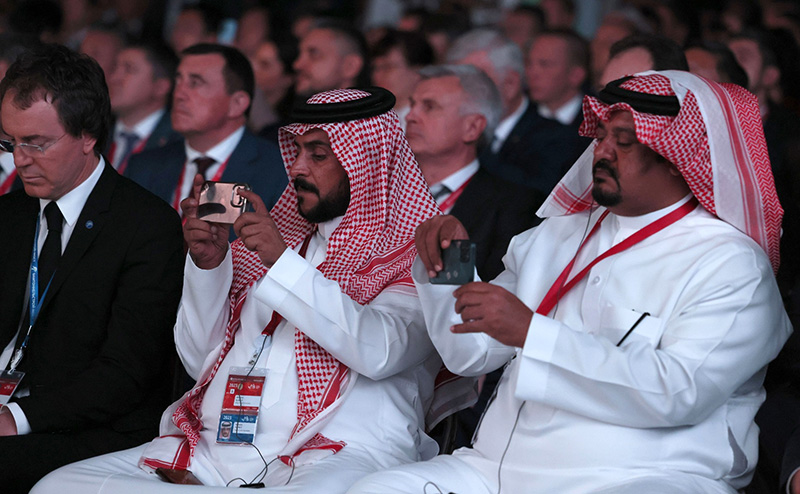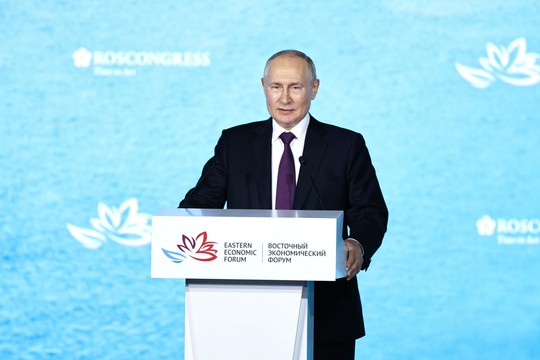All photos: Kremlin.ru
President of Russia Vladimir Putin addressed the plenary session of the 8th Eastern Economic Forum. His speech key points:
- We can all see very well the changes that the global economy has experienced in recent years and continues to experience now, including due to certain countries, primarily Western ones, of course, who are destroying the system of financial, trade, and economic relations that they had put much effort into building.
- It is very important that in these conditions the world sees the expanding space for actual business cooperation between states that do not yield to external pressure but pursue their own national interests, with a growing number of such states in different regions of the world.
- Essentially, we are witnessing a new emerging model of relationships and integration – and not by Western patterns, for the elite, for the chosen ‘golden billion,’ but for the entire humanity and the entire existing and developing multipolar world. This model offers creative energy, openness and focus on a specific outcome as a powerful competitive advantage of the Asia-Pacific region, a key factor that determines and I am sure will determine for a long time its global leadership in economic growth.
- Notably, last year Russia's trade with Asia-Pacific countries increased by 13.7 percent and added another 18.3 percent in the first six months of this year. It was up 13.7 percent for the whole last year and this year, it is up 18.3 percent just in the first six months.

- The Far Eastern Federal District accounts for 40 percent of Russia’s territory. Almost half of our forestland and gold reserves, more than 70 percent of our fish, diamonds, and over 30 percent of titanium, copper and so on are located here. Critically important strategic enterprises, seaports and railroads are located here. In short, the role of the Far East for our country and for its future, for Russia's position in a multipolar world is immense. We are well aware of it. That is why I would like to repeat what I said in my Address to the Federal Assembly ten years ago, in December 2013, and what I said at the very beginning: the advanced development of the Far East is our absolute priority for all of the 21st century, our shared responsibility and work of the Government, the regions and major Russian companies, both state-owned and private.
- We have come up with special tax, administrative and customs preferences in the Far East in order to promote the development of industrial sites and high-tech production facilities and to create new jobs, and we have taken on the construction of infrastructure and bringing utilities to industrial sites. This business support is provided in the priority development areas and the free port of Vladivostok, although other territories have been added to this port as well.
- Last year, a special preferential regime was launched on the Kuril Islands, on even more favourable terms than in the priority development areas: the duration of benefits is longer, the tax cuts are greater, and so on.
- Thanks to the Government support for the Far Eastern projects, investment agreements have been signed for over 7.7 trillion rubles, 3.4 trillion of which have already been invested. As many as 125,000 jobs have been created, and about 700 new enterprises have become operational.
- In general, the investment dynamics in the Far East, and I would like to emphasise this, are three times faster than in Russia as a whole. While from 2014 to 2022, the growth in investment in fixed capital across the country was 13 percent, in the Far East it was 39 percent. This is also reflected in production output. Industrial growth rates in the Far East also exceed the Russian average.
- According to the results of the last five years, most of our eastern regions – the Magadan and the Amur regions, the Trans-Baikal Territory, the Jewish Autonomous Region, the Amur river basin, Chukotka and Kamchatka – are among the top 20 constituent entities of the Russian Federation in terms of gross regional product growth rates, and the Magadan Region tops this rating.
- I should note here that the average percentage of explored subsurface resources in the Far East is now 35 percent. You understand, only 35 percent of the subsurface area has been explored. What does this mean? It shows that there is every opportunity for the mining industries to grow by leaps and bounds, including the strategic raw materials that are in short supply, and which will be in demand in the economy of the future.

- The prospects for the Far East and the Arctic are related not only to the development of mineral deposits, which, without a doubt, enjoy high demand both in the domestic industry and internationally.
- Plans call for connecting the Sila Sibiri (Power of Siberia) and Sakhalin-Khabarovsk-Vladivostok gas pipelines and then for including them in the country’s integrated gas supply system. That will resolve – I dare say – a historical and global task for our country: to integrate the Russian western and eastern gas distribution networks into one.
- This sector is developing actively, including in the Arctic. After the successful launch of the Yamal LNG project, a new major project has been started to build an LNG terminal in the Arctic: the first technological line of the Arctic LNG 2 project. It has already been delivered to the production site, and the startup work is underway, am I right? That’s great.
- I want to note that the line is in fact a floating plant to liquify natural gas. This project is the only one of its kind in the world, it is safe to say, and is built with Russian technology and capacities. The project is being implemented by the Murmansk LNG Construction Centre, which manufactures GBS liquefaction trains.

- Certainly, development of the Northern Sea Route has special priority among these projects. Thirty-four million tonnes of cargo were shipped using the route last year. In the next few years, the cargo traffic on this global transport corridor will only grow, which requires prioritising the construction of a modern icebreaker fleet, as well as upgrading Arctic ports and their infrastructure.
- By 2030, we expect the general capacity of seaports in the Arctic waters to double. While last year, this capacity stood at 123 million tonnes, by the end of the decade it is expected to reach 252 million tonnes, in part thanks to the construction of new terminals and the expansion of railway access.
- In this connection, I want to note that, thanks to the initiative of private investors, we are building the Pacific Railway and a new port on the Sea of Okhotsk, which will allow us to utilise the resources of Yakutia and the northern regions in the Khabarovsk Territory, and to secure direct access to Asia-Pacific markets.
- I have already told Russian business leaders, many of whom are facing pressure from some of our partners, and I want to reiterate today that it is definitely better and more reliable to invest in Russia, both in major, ambitious infrastructure projects and local but important projects related to urban development and tourism. We see what happens with capital and how and where it goes. Do not make the same mistake twice.
- Just recently, we have opened a section of the high-speed motorway from Moscow to Arzamas. By the end of this year, the road will reach Kazan, and then Yekaterinburg and Tyumen. I want to say that we will certainly continue this major project and build high-speed roads across Siberia and the Far East to reach the Pacific Ocean. The Rossiya integrated transport corridor will be created from St Petersburg to Vladivostok.
- A separate matter is the development of air travel between the Far East and the European part of Russia, as well as improving direct interconnectivity of the Far Eastern regions, so that people would not have to fly to neighbouring regions via Moscow or Siberian airports. To that end, as you know, we created an integrated Far Eastern airline.
- The most important and integral goal of our plans, which we are implementing in the economy, transport and infrastructure of the Far East, is to improve the quality of life, to create comfortable and modern conditions for study and work, leisure and raising children, and to achieve sustainable population growth in Russia’s Far Eastern regions.
- For this purpose, a number of mechanisms have been launched, including the Far Eastern Hectare programme. More than 119,000 people have received land plots for doing business, opening production and tourist facilities, or building their own homes.
- A separate and major area of work that we have launched is the revival of 25 agglomerations and cities in the Far East… The cities should get a new look based on the development of qualitative master plans based on the problems and advantages of each particular city. The master plans are more or less ready.
- Russia’s Far East should not be solely a territory where the economy, social sector and urban environment are developing rapidly. While pursuing these plans and projects, we should not neglect efforts to take care of unique ecosystems and preserve hundreds of rare plant and animal species. Incidentally, the international forum Falcon Day has been held for the first time as part of the current Eastern Economic Forum, with the aim of discussing the preservation and growth of the population of predatory and rare bird species. I would like to thank our friends and colleagues from the Middle East, who are paying particular attention to this issue. And we will obviously work with you, colleagues, on this humanitarian yet very engaging matter.

- Russia’s Far East has more than 60 specially protected natural areas of federal significance, many included on the World Natural Heritage Sites list such as Lake Baikal, Lena Pillars Nature Park, Wrangel Island Reserve, volcanoes of Kamchatka, and others. All this is our core national wealth and at the same time it is global heritage; we are obliged to preserve it while providing opportunities for scientific research, for education and recreation of children and young people, and for Russian and foreign tourists and visitors to get to know the wonderful nature of our Far East.
- I have mentioned that the Russian Far East should become a platform for new economic sectors, including the development of tourism in national parks in the Primorye and Khabarovsk territories, Yakutia, Buryatia, Kamchatka, the Kuril Islands and other regions.
- Much has been done for the Far East and the Arctic over the past ten years. A powerful boost has been given to the development of the economy, the social sphere and infrastructure, and the environment for doing business that has been created is unparalleled in our country. I am not afraid to use this word: it is an unparalleled environment. We have launched major landmark projects in the production of natural resources and the manufacturing industry, housing construction and upgrading of the transport network. Plans to modernise cities and towns have been drawn up and are being acted upon.
- To reiterate, the Far East remains our strategic priority for the rest of the 21st century. I would like to end my remarks with the opening lines. I am sure its role, as well as the role and importance of our country in the world, will only grow.
read more in our Telegram-channel https://t.me/The_International_Affairs

 18:50 12.09.2023 •
18:50 12.09.2023 •























